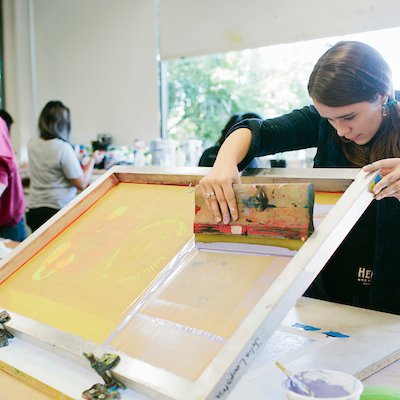ChatGPT said: 10:9 Design Screen Printing Texas: costs explained
Wiki Article
The Vital Guide to Understanding Screen Printing and Its Versatile Makes use of
Screen printing has an abundant history that goes back to ancient times, evolving right into an advanced strategy utilized throughout numerous sectors today. This guide discovers the details of the screen printing process, outlining its applications in home, fashion, and advertising style - 10:9 Design Embroidery. Recognizing these principles can open up imaginative capacity for both industrial and creative tasks. The complying with areas will expose crucial ideas and strategies to boost one's screen printing undertakingsThe Background of Screen Printing
Although screen printing has origins that trace back centuries, its advancement shows the imaginative and technical innovations of various societies. Coming from in ancient China, the strategy was at first used for enhancing textiles and later infect Japan, where it ended up being important to Ukiyo-e woodblock printing. The method changed to Europe in the 18th century, where it got popularity amongst artisans and business printers. The creation of photo solution in the 20th century transformed screen printing, permitting for more detailed styles and greater performance. Artists like Andy Warhol further thrust its popularity, making use of the medium to develop renowned jobs that mixed commercialism and great art. By the late 20th century, screen printing had developed itself as a versatile strategy, employed in style, advertising and marketing, and fine art. Today, it proceeds to progress, integrating electronic technology and broadening its applications throughout various sectors.The Screen Printing Process Explained
Screen printing transforms imaginative visions into concrete designs with a collection of accurate actions. Initially, a photo is created and afterwards moved onto a screen, usually constructed from fine mesh textile extended over a frame. A light-sensitive solution is put on the screen, which is exposed to light, solidifying in locations not covered by the photo. After rinsing the unhardened solution, a stencil is formed.Next, the screen is positioned over the substratum, whether it be fabric, paper, or one more product. Ink is after that pressed via the open locations of the pattern using a squeegee, depositing the style onto the substratum listed below. This procedure can be duplicated for numerous shades, requiring different screens for each shade. The printed thing is healed making use of warmth to ensure the ink adheres correctly, resulting in a resilient, dynamic design ready for usage.
Kinds Of Screen Printing Techniques

Furthermore, specialized strategies, such as discharge screen printing, get rid of dye from the material to produce softer prints, while aluminum foil screen printing uses metal foil to achieve a shiny surface (10:9 Design Abilene). Each technique uses unique features, satisfying numerous imaginative needs and production scales, ultimately expanding the opportunities within the screen printing domain name
Applications of Screen Printing in Various Industries

In addition, the signs and advertising sectors utilize screen printing for creating appealing screens and banners. This technique enables for bold colors and intricate layouts that record focus. In electronic devices, screen printing is utilized for applying conductive inks to motherboard, crucial for part links. The home design industry welcomes screen printing to create distinctive designs on fabrics and wall art. In general, screen printing acts as a critical device across diverse areas, improving products with individualized and aesthetically attractive graphics.
Tips for Successful Screen Printing Projects
While undertaking a screen printing task, cautious interest to detail can substantially improve the final end result. Initially, selecting premium materials is crucial; this includes the screen, inks, and substratums. Utilizing appropriate mesh matters can impact ink deposition and detail resolution. Preparation is just as crucial; complete cleansing of displays and proper direct exposure times assure crisp prints.Next off, precise registration is crucial for multi-color prints. Utilizing placement devices can help attain accurate layering. Furthermore, testing prints on scrap materials before production helps recognize prospective issues without throwing away resources.

Often Asked Concerns
What Materials Are Finest for Screen Printing on Material?
Cotton and polyester blends are ideal for screen printing on textile as a result of their toughness and ink absorption. In addition, specialty textiles like silk or canvas can generate one-of-a-kind structures and finishes, improving the general 10:9 Design Embroidery layout high quality.Just how Do I Clean and Maintain Screen Printing Tools?
To clean up and keep screen printing equipment, one ought to routinely clean screens with suitable solvents, evaluate squeegees for wear, lube relocating parts, and shop all products in a dry, dust-free setting to prolong their life expectancy.What Are the Ecological Impacts of Screen Printing?
Screen printing can have considerable ecological impacts, consisting of chemical waste from solvents and inks, water usage during cleansing procedures, and energy consumption. Eco-friendly materials and lasting techniques are vital for decreasing these negative effects.Can Screen Printing Be Done in your home Properly?
Screen printing can be effectively done at home with the best materials and methods. Enthusiasts can develop top quality prints, though success depends on their skill level, equipment, and understanding of the process included.
What Are the Expenses Connected With Beginning a Display Printing Organization?

Starting a screen printing company includes costs for equipment, materials, and workspace. First expenditures commonly vary from a couple of hundred to a number of thousand dollars, depending on the scale, top quality of equipment, and preferred production capacity.
Screen printing has an abundant background that dates back to ancient times, developing into an innovative strategy utilized across various industries today. One more method, rotary screen printing, utilizes cylindrical screens, facilitating continuous printing on textile rolls, consequently improving effectiveness for large-scale productions. In addition, specialized strategies, such as discharge screen printing, eliminate color from the fabric to develop softer prints, while foil screen printing uses metallic aluminum foil to achieve a glossy finish. In the style industry, screen printing is extensively utilized to develop dynamic designs on clothing, enabling brands to showcase their special styles. Cotton and polyester blends are suitable for screen printing on fabric due to their durability and ink absorption.
Report this wiki page